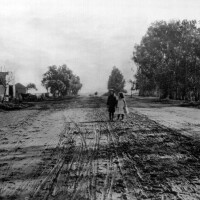Before Suburbia, Agriculture Dominated the San Fernando Valley

If it were a separate city, the San Fernando Valley would be the fifth largest in the nation. With more than 1.7 million inhabitants, it is one of California’s largest suburban areas and epitomizes suburbia in the public imagination. However, for much of its early history, the region was a sparsely populated agricultural hinterland, just over the hill from Los Angeles. Even as L.A.’s urban spaces expanded through the late 19th and early 20th centuries, the valley remained largely rural and did not experience its full transformation into an immense suburban area until the latter half of the 20th century.
In the decades following America’s conquest of California, remnants of the valley’s early rancho days remained. Owned largely by Pio Pico, California’s last governor under Mexican rule, the valley was well known for its cattle and sheep. A severe drought in 1862-63, however, hastened the disappearance of daily cattle roundups in the area and ranchos, including Rancho Encino, turned their focus to sheep shearing.[1]

On May 1, 1874, the completion of the Southern Pacific rail line to the northeast end of the San Fernando Valley marked the beginning of a new period in the valley’s history. Though it never precipitated the immediate development that land speculators like Isaac Lankershim and his son-in-law Isaac Newton Van Nuys so eagerly expected, the railroad and the regional connections it provided allowed agriculture to flourish.[2] As a result, gentlemen farming, or small-scale suburban agriculture, came to dominate the valley landscape till the start of World War II.
A series of droughts convinced many farmers by the 1890s to adopt dry farming practices in hopes of turning a profit despite the uncontrollable weather. Some grew citrus and fruit, but valley farmers more notably became dependent on grain production, which replaced sheep raising as a primary practice.[3] Still, these dry farming tactics could not last. Continued unpredictable climate and the crucial importance of agriculture to local inhabitants necessitated the establishment of a large-scale irrigation system. This system, the first of which was built from 1915 and 1917, provided a missing link that allowed for the production of a wider variety of crops and the unprecedented growth of local farm villages.[4] As agriculture expanded throughout the valley, towns and areas became known for the production of certain crops. Limited to higher altitudes, citrus farms were commonly found on slopes in Encino, Pacoima, Canoga Park and Chatsworth while poultry and dairy farms were rooted in Reseda, Mission Acres, North Hollywood and Van Nuys. [5] The San Fernando Valley also became known for its abundance of walnut orchards in addition to its vast fields of grapes, tomatoes and lima beans.[6]
Well through the Depression years, agriculture would remain an important part of valley life, peaking in 1930 with a total of 58,359 rotating crops.[7] Beginning in 1940, however, agricultural started to fade as the region’s population continued to grow and farmland gave way to suburban development. From 1950 to 1960, the valley, according to local historian Jackson Mayers, “outgrew all other major city areas in the United States,” thrusting it from the 25th to the 9th largest urban center in the nation.[8] As a result, by 1967, “40% of the land was residential, 3% commercial, 4% industrial, 16% public.” Still, despite such massive development, 33% either remained agricultural or vacant.[9]
The importance of agriculture to valley sustainability and growth cannot be understated. Sold locally as well as nationally, the crops cultivated across the valley floor served as a main source of profit for local farmers in its early years. More importantly, the money agriculture brought to the region helped boost the local economy, which benefited not only valley inhabitants, but also reassured prospective residents that the seemingly bare valley was a sustainable, profitable and desirable place to live.













Notes
[1] Jackson Mayers, The San Fernando Valley (Walnut, CA: John D. McIntyre, 1976), 56, 58, & 62.
[2] Lewis Height, Settlement Patterns of the San Fernando Valley, Southern California (1953), 48.
[3] Height, Settlement Patterns of the San Fernando Valley, 49-50.
[4] Mayers, The San Fernando Valley, 112 & Height, Settlement Patterns of the San Fernando Valley, 89.
[5] Height, Settlement Patterns of the San Fernando Valley, 94-97.
[6] Kevin Roderick, The San Fernando Valley: America’s Suburb (Los Angeles, CA: Los Angeles Times Books, 2001), 71.
[7] Height, Settlement Patterns of the San Fernando Valley, 97.
[8] Mayers, The San Fernando Valley, 172.
[9] Mayers, The San Fernando Valley, 204.


